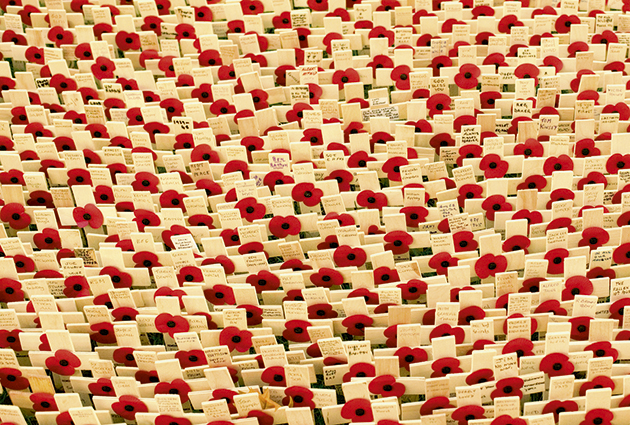Meet the poppy makers
Did you know that most poppy-makers are either war veterans or disabled dependants of military personnel?


We all reflect on the sacrifice, futility and horror of war when pinning a poppy to our lapel, but few of us realise that it could have come from the very same workshop that first established the poppy as the world’s most enduring symbol of remembrance nearly a century ago.
Poppy manufacture is big business. More than 35 million paper poppies are made on the Royal British Legion’s automated production line in Aylesford, Kent, and at the Lady Haig factory in Edinburgh, but tucked away on Richmond’s leafy Petersham Road is the original Poppy Factory, where a small team is proud to be part of history.
The remembrance poppy derives from two chance events that occurred in New York, 48 hours before the cessation of hostilities. On November 9, 1918, teacher Moina Bell Michael was volunteering at a YMCA conference.
During a break, she glanced through the Ladies Home Journal and read John McCrae’s poem We Shall Not Sleep (In Flanders Fields the poppies blow/Between the crosses, row on row), composed during the second Battle of Ypres in 1915. It was, she wrote, ‘a full spiritual experience. It seemed as though the silent voices again were vocal, whispering, in sighs of anxiety unto anguish’.

Then, unexpectedly, a delegate offered Michael a $10 tip. She resolved to spend the windfall on silk poppies and ask the conference to wear them in homage. A harder task than anticipated, she finally tracked down two dozen in Wanamaker’s department store. Michael then campaigned tirelessly and the ‘torch and poppy’ emblem was launched on February 14, 1919, at the Carnegie Hall lecture given by Canadian flying ace Col ‘Billy’ Bishop, VC. It was two more years before the concept was picked up worldwide, thanks to a Frenchwoman, Anna Guérin, who made the seminal link between poppies and fundraising.
In 1921, she met Field Marshal Earl Haig, founder of the British Legion. He launched the British Poppy Day Appeal that year, using Guérin’s French flowers.
The first British poppies were crafted by five men, a group set up in the Old Kent Road in 1922 by Maj George Howson, MC. He had served on the Western Front, had already founded the Disabled Society and suggested the ‘factory’ concept to a receptive Haig.
Exquisite houses, the beauty of Nature, and how to get the most from your life, straight to your inbox.
Howson wrote home: ‘I have been given a cheque for £2,000. It is a large responsibility and will be very difficult. I do not think it can be a great success, but it is worth trying. I consider the attempt ought to be made, if only to give the disabled their chance.’ By 1925, the premises were heaving under the demand and the Poppy Factory moved to its current site.
At its height in 1932, Richmond employed 360 people. Some equipment was designed specifically for men who had lost an arm two people could operate the heavy embossing press in tandem. Archive photographs would send today’s health-and-safety experts into paroxysm; one depicts workers cheerfully smoking while knee-deep in off-cuts. Nowadays, Richmond’s 30 regular workers handle the bespoke remit.

A mix of former servicemen and disabled dependants of former military personnel, this cheerful team contributes 500,000 paper lapel poppies (although it’s primarily responsible for ‘silk’ floral tributes), 130,000 dinner-plate sized wreaths, the millions of crepe petals released in the Royal Albert Hall during the Festival of Remembrance and hundreds of made-to-order large items. These include the display around the tomb of the Unknown Warrior in Westminster Abbey and wreaths laid by senior members of the Royal family.
The Queen’s simple wreath is similar to that of George VI, with poppies in a semi-closed, conical shape; The Duke of Edinburgh’s has a plain, flower-free top. The Prince of Wales’s is the most elaborate, with his ‘feathers’ embellished in white carnations and the poppies graduated in size.
Unavoidably, the ‘silk’ poppies are now fashioned from imported polyester. ‘Wherever possible, we source materials locally, but for some products, China has cornered the market on price,’ explains factory manager Bill Kay.
The team also assembles 3,000 small wooden crosses per day, with variants for other main faiths and agnostics. Plastic components are designed for quick slot-assembly and are mostly manufactured off-site, some by inmates at Ford Open Prison, although all poppies are machine-cut and crimped on-site.
The Richmond team has developed some simple but reliable techniques. The bases for large display wreaths are cut from insulating board and effectively weatherproofed with layers of duct tape. Tour groups are often baffled to see so many denuded broom-heads lying about. Bristles provide a brilliant finishing touch; cut out a cluster, dip the tips in glue and sawdust and, voila poppy stamens.
Country Life is unlike any other magazine: the only glossy weekly on the newsstand and the only magazine that has been guest-edited by His Majesty The King not once, but twice. It is a celebration of modern rural life and all its diverse joys and pleasures — that was first published in Queen Victoria's Diamond Jubilee year. Our eclectic mixture of witty and informative content — from the most up-to-date property news and commentary and a coveted glimpse inside some of the UK's best houses and gardens, to gardening, the arts and interior design, written by experts in their field — still cannot be found in print or online, anywhere else.
